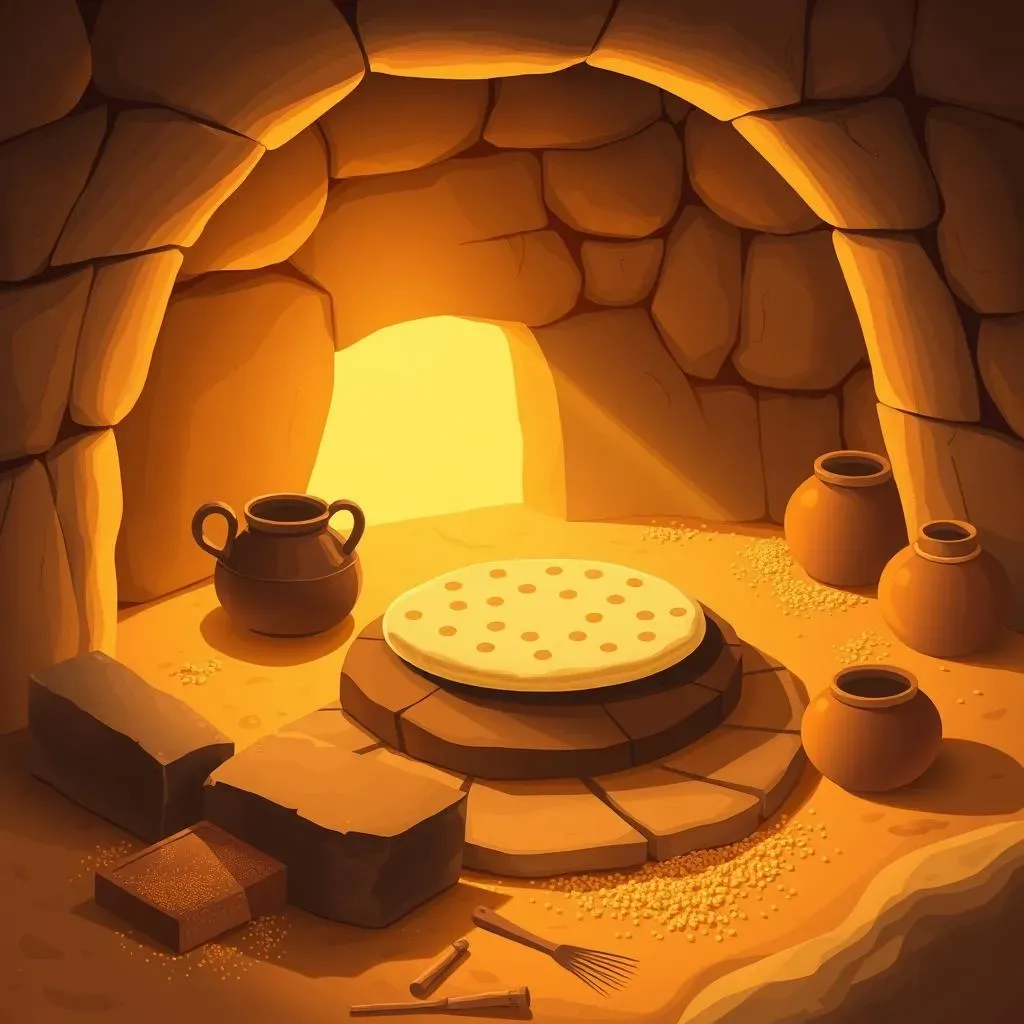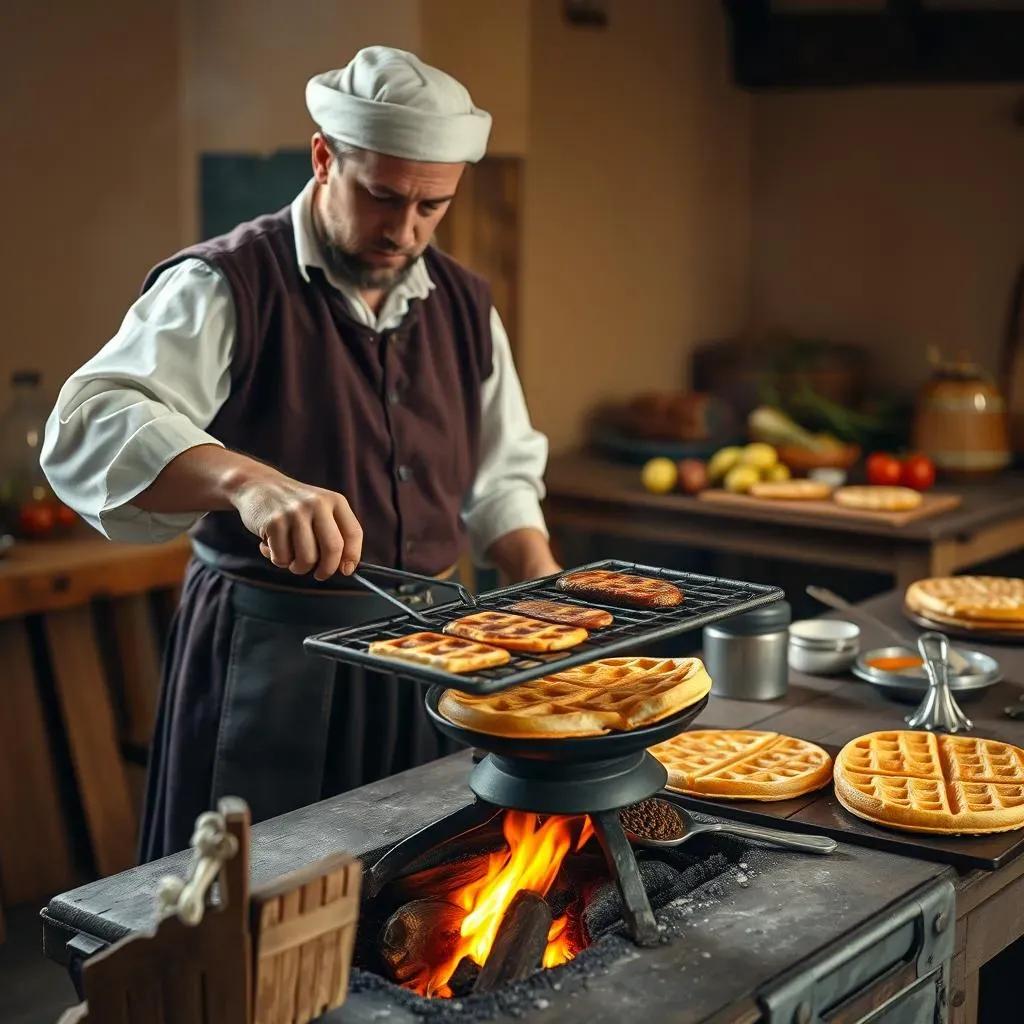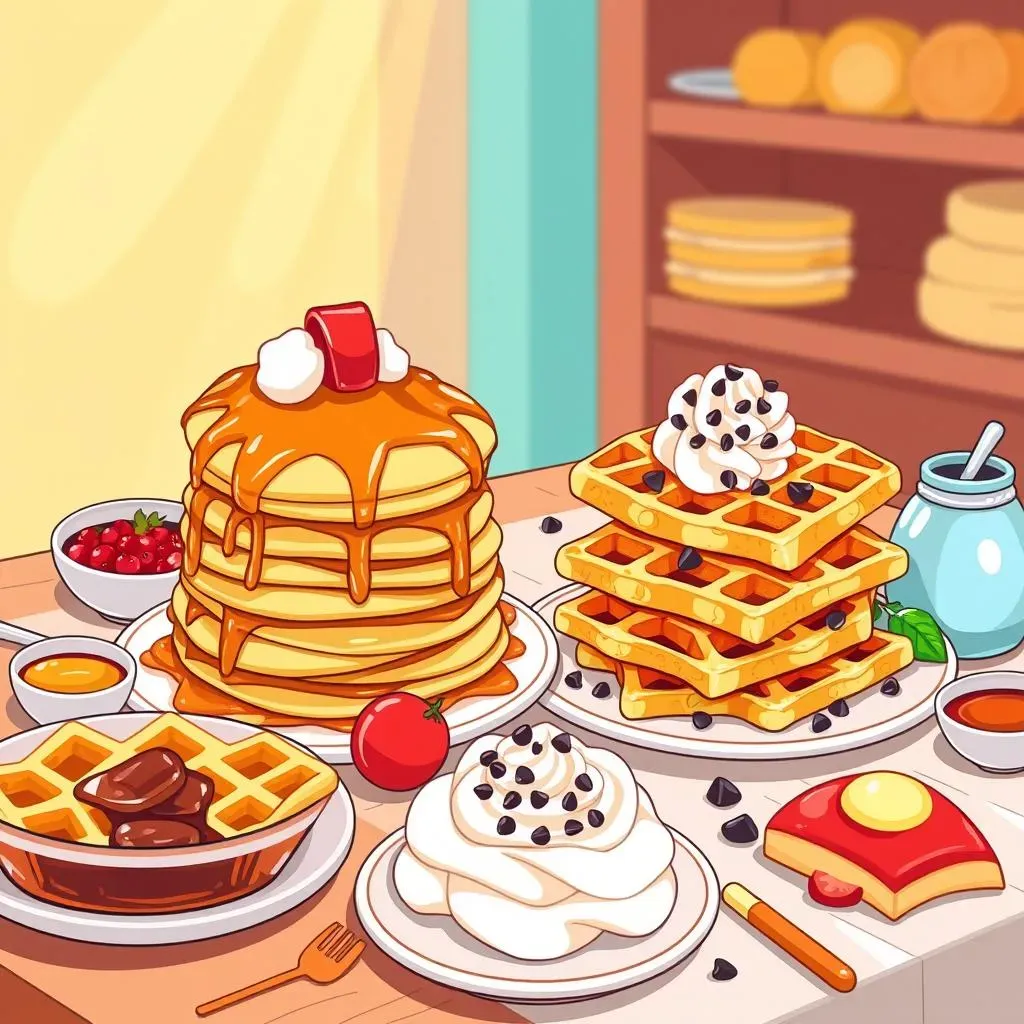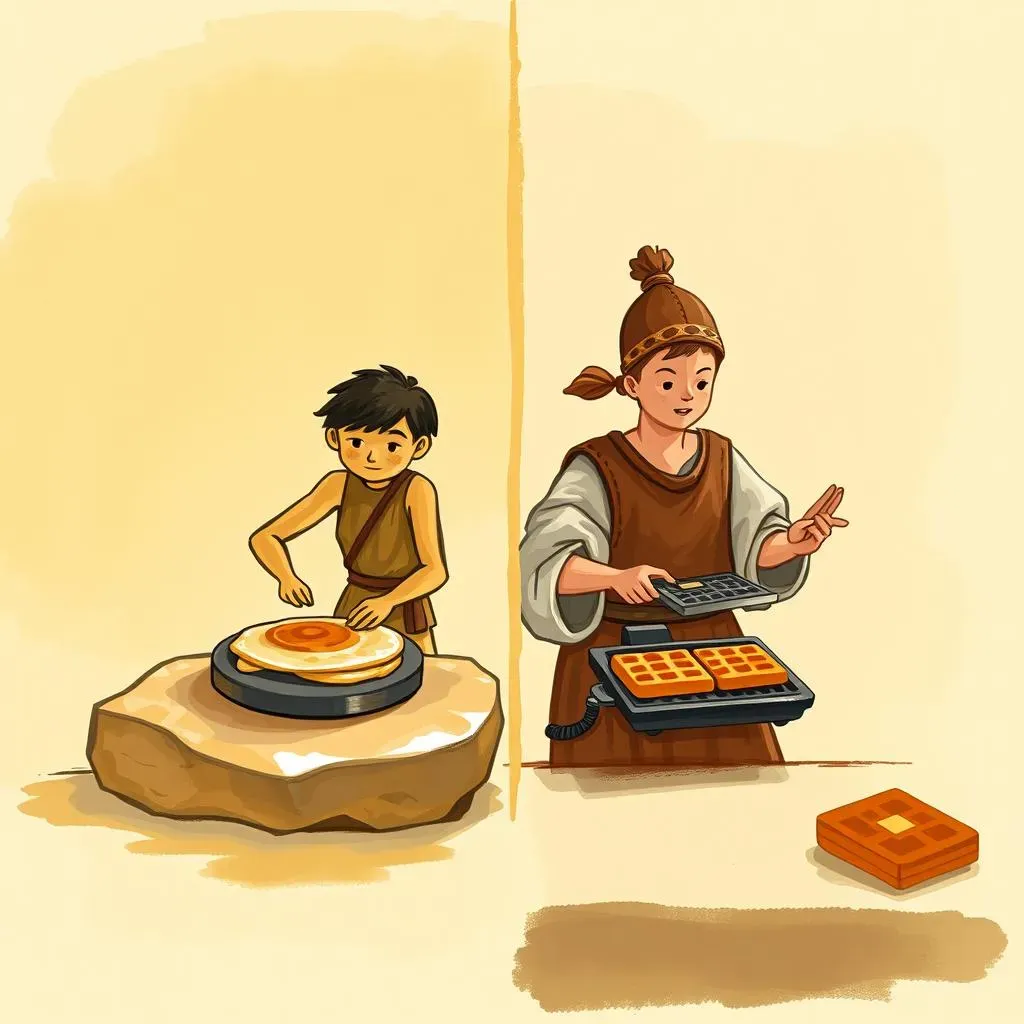Table of Contents
Ever found yourself pondering the great breakfast debate: did pancakes or waffles come first? It's a question that has likely crossed your mind as you've stood in front of a stack of fluffy goodness or a grid-patterned delight. This isn't just about which is tastier, it's a journey through culinary history. We're going to travel back in time, way before your favorite diner, to uncover the surprising origins of these breakfast staples. Forget the syrup for a moment, and get ready to explore ancient civilizations, medieval kitchens, and the global spread of these beloved treats. We'll look at the early forms of each, how they evolved, and finally, try to settle the age-old question of which came first. So, grab your fork and let's dig in, because the answer might just surprise you! This article will explore each origin and compare them to each other.
Ancient Origins: Did Pancakes Come First?

Ancient Origins: Did Pancakes Come First?
The Dawn of Flatbreads
Alright, let’s get one thing straight: when we talk about pancakes, we’re not necessarily picturing the fluffy, syrup-drenched stacks we know today. We're going way back, like, way, way back. Imagine early humans, maybe even before they had fancy pottery. They mixed ground grains with water, maybe some milk if they were lucky, and then cooked it on hot stones. These weren't exactly the pancakes you get at your local diner, but these flatbreads were the ancestors of what we know and love. They were simple, filling, and incredibly important for survival.
Think of it like this, making these early pancakes was like the first step in the history of cooked food. It's how people turned basic ingredients into something nourishing and delicious. It's a history lesson you can eat.
Ancient Greece: The First Real Pancakes?
Now, let's fast-forward to ancient Greece, around 1100 AD. Here, we see what might be considered the first "real" pancakes. These weren't just basic flatbreads; they were called "tagenias" and were made with wheat flour, olive oil, honey and curdled milk. These tagenias were cooked on hot stones and often eaten for breakfast. Sounds pretty good, right? They even had different versions depending on what was available and the occasion. This isn't just a simple flatbread anymore, It's evolving into something more like what we recognize today. It's amazing to think that people thousands of years ago were enjoying something so similar to what we eat on weekend mornings.
Civilization | Time Period | Pancake Type | Ingredients |
|---|---|---|---|
Early Humans | Pre-Pottery | Basic Flatbread | Ground grains, water |
Ancient Greece | 1100 AD | Tagenias | Wheat flour, olive oil, honey, curdled milk |
Pancakes Around the World
It isn't just the Greeks who had their version of the pancake. Cultures all over the world have created their own flat, cooked batter treats. In Asia, there’s the Chinese "bing", a thin, savory pancake. In parts of Africa, you find similar flatbreads made from various grains. These are all part of the wider pancake family, showing how similar needs and ingredients can lead to similar culinary creations. It's a wonderful reminder that food connects us across time and cultures. Even if the recipes and names change, the basic idea of cooking a simple batter on a hot surface is timeless.
So, when we're talking about the origin of pancakes, it's really about this ancient, almost universal desire to turn simple ingredients into something satisfying and delicious. The Greeks just gave it a name and refined it a bit. It's a story that's still being written every time someone flips a pancake on a griddle.
Medieval Waffles: The Rise of the Grid

Medieval Waffles: The Rise of the Grid
From Simple Cakes to Gridded Goodness
Okay, so we've seen how pancakes got their start, but what about waffles? Well, they didn't just pop up out of nowhere. Think of the Middle Ages, around the 13th and 14th centuries. People in France and England were making these flat cakes, kind of like pancakes, but they were starting to get a little fancier. They weren't content with just a flat surface; they wanted texture, they wanted something special. This is where the idea of using a grid iron came into play. These weren't the fancy electric waffle makers we have today; they were heavy, metal irons with a grid pattern, that were heated over an open fire. It’s like the pancake decided to get a makeover, and the grid was its new, stylish haircut.
These early waffles, called "gaufres" in French, were made from a batter of flour, water, and sometimes milk or eggs. They cooked them in these grid irons, and that's how they got their signature pattern. It's like they were saying, "Hey, we're not just pancakes, we're something else entirely!" This was a big step in the evolution of the waffle. It's like someone said, "Let's make this breakfast thing a little more interesting," and the waffle was born out of that creative spark. It wasn't just about taste anymore; it was about the experience of that unique, textured bite.
The Waffle's Medieval Makeover
The waffle didn't stay as a simple flat cake for long. As time went on, the recipes and cooking methods evolved. People started adding different ingredients to the batter, like spices, butter, and even cheese. These weren't just breakfast food anymore; they were becoming a treat that people enjoyed at feasts and festivals. Imagine medieval fairs with the smell of freshly baked gaufres wafting through the air. They weren't just food; they were part of the experience, a little bit of luxury in a world that wasn't always luxurious. This was the waffle's time to shine, a chance to become something more than just a simple flat cake.
And it wasn't just France and England. The idea of cooking batter in a gridded iron spread throughout Europe. Each region had its own take on the waffle, with slight variations in ingredients and cooking styles. It's like the waffle went on a world tour, picking up new flavors and techniques along the way. This shows how a simple idea can transform and adapt when it travels from one culture to another. The waffle became a canvas for local tastes and traditions, making it a truly diverse and global treat.
Time Period | Location | Waffle Name | Key Features |
|---|---|---|---|
13th-14th Century | France, England | Gaufres | Cooked on grid irons, basic batter |
Later Middle Ages | Various Europe | Regional variations | Spices, butter, cheese added, festive treat |
Pancakes and Waffles: A Global Journey

Pancakes and Waffles: A Global Journey
The Pancake's World Tour
So, we've seen the pancake's humble beginnings, but it didn't stop there. It’s like it got a taste for adventure and decided to see the world. Each culture put its own spin on it, using local ingredients and cooking styles. Think of the French crêpe, a super-thin pancake that can be sweet or savory. Or the Ethiopian injera, a spongy, slightly sour flatbread made from teff flour, used as a base for many dishes. Then you have the South Indian dosa, a crispy pancake made from fermented rice and lentils. It’s the same basic idea – batter on a hot surface – but the results are totally different. It's like the pancake is a chameleon, adapting to its surroundings while still being itself.
These aren't just variations; they're reflections of local tastes and traditions. In some places, pancakes are a daily staple, a quick and easy meal. In others, they’re a special treat for festivals and celebrations. It's amazing how this simple dish has become so deeply embedded in different cultures. It's a testament to the versatility of the pancake and how it can bring people together, no matter where they are in the world. Each version tells a story about the people who make and eat it. It really shows how food can be a universal language.
Waffles Across Continents
The waffle also embarked on its own global journey, though its path was a bit different. While pancakes seemed to pop up everywhere, waffles were often introduced through trade and migration. When Europeans moved to new lands, they brought their waffle irons with them. This is how the waffle arrived in the United States, where it became a breakfast staple. But even as it traveled, the waffle didn't stay the same. Different regions added their own twists, like the Belgian waffle, which is thicker and often served with whipped cream and fruit. In Hong Kong, you'll find a bubble waffle, a sweet street food treat with a unique bubbly texture. It’s like the waffle was a traveler collecting souvenirs, each one a new flavor or style.
This shows how a dish can evolve and adapt in new environments. The waffle, with its distinctive grid pattern, became a blank canvas for new flavors and toppings. It's a reminder that even with a shared history, each culture has the power to create something new and unique. It's like the waffle is a living, breathing thing, constantly changing and evolving as it moves through time and space. It’s a testament to the power of human creativity and our love for good food.
Dish | Region | Key Features |
|---|---|---|
Crêpe | France | Thin, sweet or savory |
Injera | Ethiopia | Spongy, sour, made from teff |
Dosa | South India | Crispy, made from rice and lentils |
Belgian Waffle | Belgium | Thick, served with toppings |
Bubble Waffle | Hong Kong | Sweet, bubbly texture |
The Modern Breakfast Table
Today, both pancakes and waffles are loved worldwide, and you can find them in countless forms. From the simple stack at your local diner to elaborate creations in fancy restaurants, these dishes have come a long way. They're no longer just basic sustenance; they're a source of comfort, a reason to gather with friends and family, and a way to explore different flavors and textures. It's amazing to think that these two simple dishes have such a rich and complex history, and they continue to evolve and adapt to the tastes of the modern world. They’re a reminder that even the simplest things can have a profound impact on our lives.
So, the next time you're enjoying a stack of pancakes or a plate of waffles, take a moment to appreciate the long journey they've taken to reach your table. They're not just breakfast food; they're a symbol of human ingenuity and our shared love for delicious food. They're a story that spans continents and centuries, and they're a reminder that even the simplest things can have a rich and complex history. It's like every bite is a little taste of the past, combined with the creativity of the present. It's a wonderful thing to be a part of.
So, Did Pancakes or Waffles Come First? Settling the Griddle Debate

So, Did Pancakes or Waffles Come First? Settling the Griddle Debate
The Verdict: Pancakes Take the Crown
Okay, so after all that delicious history, it's time to answer the big question: did pancakes or waffles come first? The evidence points pretty clearly to pancakes. Those simple flatbreads cooked on hot stones by early humans were the very first form of what we now call a pancake. While waffles are amazing, they came along much later, in the Middle Ages, when people started using grid irons to create that unique texture. It's like the pancake was the original, and the waffle was the cool, textured remix. So, if we're talking about who came first, pancakes win by a long shot. They were there at the dawn of cooked food, while waffles joined the breakfast party much later.
It's fascinating to think that something as simple as a flat, cooked batter has such an ancient and widespread history. Pancakes weren't just a meal; they were a fundamental part of early human diets. They were a way for people to make the most of basic ingredients and create something nourishing and satisfying. Waffles, on the other hand, represent a later innovation, a step towards more complex and varied cooking methods. While they both hold a special place in our hearts (and stomachs), pancakes have a clear claim to being the first on the scene. It's a history lesson you can taste with every bite.
Why Does it Matter? The Joy of Culinary History
Now, you might be thinking, “Okay, pancakes were first, so what?” Well, it's not just about bragging rights for breakfast foods. Understanding the history of pancakes and waffles gives us a glimpse into how food has shaped human culture. It's about connecting with people from the past and seeing how they solved the same basic problems we face today: how to turn simple ingredients into something delicious. When you eat a pancake or a waffle, you're not just eating a meal; you're taking part in a tradition that stretches back thousands of years. It's like having a little piece of history on your plate.
It’s also a reminder that food is always evolving. Pancakes went from basic flatbreads to the fluffy stacks we love today, and waffles have seen their own transformations from simple grid-cooked cakes to the diverse treats we find around the world. This journey shows us that culinary creativity is a constant process, and that even the simplest foods can have a rich and complex history. So, the next time you're flipping a pancake or enjoying a waffle, take a moment to appreciate the long and delicious journey they've been on. It's a celebration of human ingenuity and our shared love for good food.
Food | Approximate Origin Time | Key Characteristics |
|---|---|---|
Pancakes | Prehistoric Times | Simple, flat, cooked on hot stones |
Waffles | Middle Ages (13th-14th Century) | Cooked on grid irons, textured |
The Final Flip: Settling the Pancake vs. Waffle Debate
So, did pancakes or waffles come first? The evidence points to pancakes as the older dish, with their origins stretching back to ancient times. Waffles, while not as ancient, made their mark in the Middle Ages, evolving from simple griddle cakes into the grid-patterned treats we know today. Both have traveled through time, adapting to different cultures and tastes, becoming breakfast champions around the world. The real winner isn't about age, it's the joy they bring to our tables. Whether you're team pancake or team waffle, the history of both is a delicious reminder of how food connects us across time and cultures. It is less about which came first, and more about which one you will enjoy next!